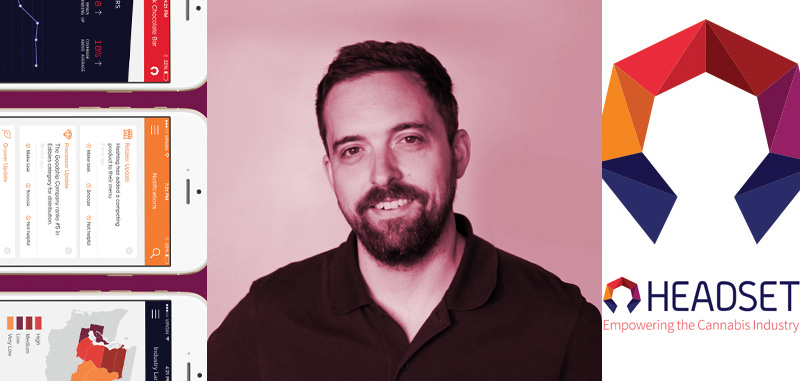
“Being a part of the cannabis industry from Leafly’s inception over 5 years ago, we’ve seen first-hand some critical gaps in the space. One of the biggest gaps that we’ve heard from businesses in the industry over and over again is limited access to good, real-time market intelligence and operational data.”
We recently had the opportunity to ask Cy Scott, the CEO of Headset, about his experience at Leafly and how his new company will help empower cannabis pioneers to make better business decisions.
Read the full interview below:
Before you co-founded Leafly, what were you doing?
All the Leafly founders were working at Kelley Blue Book’s kbb.com, in fact that’s where Scott (CTO Headset) and myself met Brian (CDO Headset). Scott and I met in college. At KBB I had moved from the engineering team into the product management team where I was on a team tasked with a significant redesign of the site, this was in 2010 or so. While at KBB Scott, Brian and myself got the company it’s first patent for a valuation process to verify used cars, a little skunkworks project that expanded into something that was eventually productionalized. I should see if they still have it on the site actually…
When did you first recognize the cannabis industry as an opportunity for someone with your skill set?
It was a real emerging space, although we never suspected it would have progressed as far as it has today. We were in California at the time, and had seen this explosion of dispensaries with all these different strains. It was a whole new world to us, having such access to such a variety but there really wasn’t a good resource to help people make sense of it all. Some sort of database of cannabis strains idea emerged. But making a site about cannabis was nothing new, a site that targeted a broader, more mainstream applying a nice design aesthetic hadn’t really existed yet, and it made waves.
How long did it take Leafly to become one of the leading platforms for cannabis strain information?
A long time. I think its a common sentiment that something exists in some form and has always existed in such a form, and that applies to perceptions of success — but it really takes time. We got a lot of interest early on from some blog posts on some startup-y forums like Hacker News, which in turn drove additional interest but that eventually slows down. It’s then slow growth over time. I think its rare for the Instagrams or Facebooks of the world where they get this viral adoption curve (as is often common with highly social apps), at Leafly ours was much more linear but has no signs of slowing down anytime soon.
What was one of the greatest obstacles you faced while growing the business?
Growing from 3 founders to a mid-stage business with 30+ employees is tricky. Now Leafly has to undergo this sort of mid-stage to late-stage transition. Every transition can be difficult. It’s difficult to keep the culture, the vision and team challenged, happy and in the correct positions. Change is tough and I think each big iteration was difficult for us as I’m sure it is for most startups. Growing pains!
Was there ever an “oh shit” moment when you thought the whole project was going to come crashing down? If so, how did you overcome it?
Never anything that drastic, but struggling to connect with investment money was definitely a tough part early on. We had bootstrapped Leafly from the beginning, and while we had plenty of growth and traction we definitely had a hard time finding money, due to being in cannabis in 2010. We thought that if we didn’t find a partner / investor we’d have to keep the lights on but not have the time or energy to keep investing effort and growing the brand.
Leafly was acquired by Privateer Holdings in 2012 — what can you tell us about how that deal came to be? Had you received any offers from other investors prior to that?
Until Privateer Holdings came around, we really hadn’t much success with standard venture capital. While we’d had some meetings and our numbers looked great on paper, being in the cannabis industry at that time wasn’t something investors were okay with. It really wasn’t until after the elections and the passing of Amendment 64 in Colorado and i502 in Washington that year that investors started looking at cannabis as an investment opportunity. Privateer had a similar vision for the cannabis space as Leafly, and wanted to own us to be a portfolio company which would help further investment. We liked the Privateer founders and were aligned with their vision and the rest is history. Leafly wouldn’t have been as successful as it is today without Privateer’s backing and support, and I think Privateer benefited from having Leafly as a portfolio company early on.
Recently, news broke that you, Scott, and Brian have departed Leafly to create a new cannabis start-up, Headset, which will provide “data driven insights” to cannabis companies. Can you explain briefly what Headset’s services will entail?
Being a part of the cannabis industry from Leafly’s inception over 5 years ago, we’ve seen first-hand some critical gaps in the space. One of the biggest gaps that we’ve heard from businesses in the industry over and over again is limited access to good, real-time market intelligence and operational data. We are building Headset as a SaaS platform to provide these data driven insights to the cannabis ecosystem by leveraging multiple sources of data as input and outputting insights backed up by the reframed data.
What types of data will business owners be able to access and analyze with Headset, and what are some of the data sources that Headset’s insights will be based on?
Market intelligence services and operational insights mostly. We’ll be able to provide things like opportunity identification, competitive set analysis, demand forecasting and industry trends just to name a few. We use a variety of data sources such as point-of-sale integrations. It’s still very early on, but we’ve got some really interesting stuff on the way and I look forward to sharing more as we’re closer to announcing.
What types of companies will be using Headset when it launches, and will there be specific versions of for different business models?
Our primary customer segments will be the grower, product manufacturer and retailer with specific versions for each, as each segment has a different set of needs. We also will be supporting ancillary businesses and publishers as well, as a variety of businesses need access to real-time accurate market data.
What will be your primary role with Headset?
I am the Headset CEO. At a startup you wear many hats, so early on as CEO I will have responsibilities that include product, engineering, design, marketing, growth and sales in some shape or form. We’ve also raised a seed-round of capital which will help us begin to scale up these areas.
As a consumer, do you have any personal favorites among the cannabis product brands that have emerged in the legal industry?
My favorite product manufacturers are those that can provide consistency and good branding, something we’re seeing more and more of every day. Brands that push the envelope in that sense are forward thinking, and I believe a model for what nationwide legalization will look like.
What is one piece of advice you would give to an aspiring ganjapreneur?
Leverage data in your decisions. This isn’t easy to do at the moment, but will become much more accessible once Headset launches. Without good data you are taking best guesses, which may or may not work out in the long term.
Thank you for sharing your experience, Cy! To learn more about Headset, visit their website and subscribe to their newsletter.
Questions or comments? Post them below!
End
